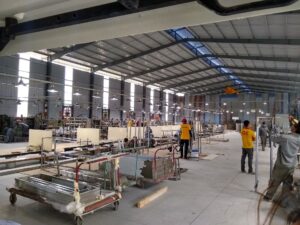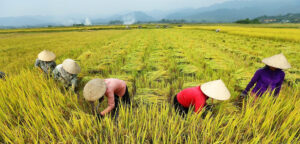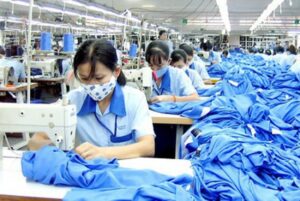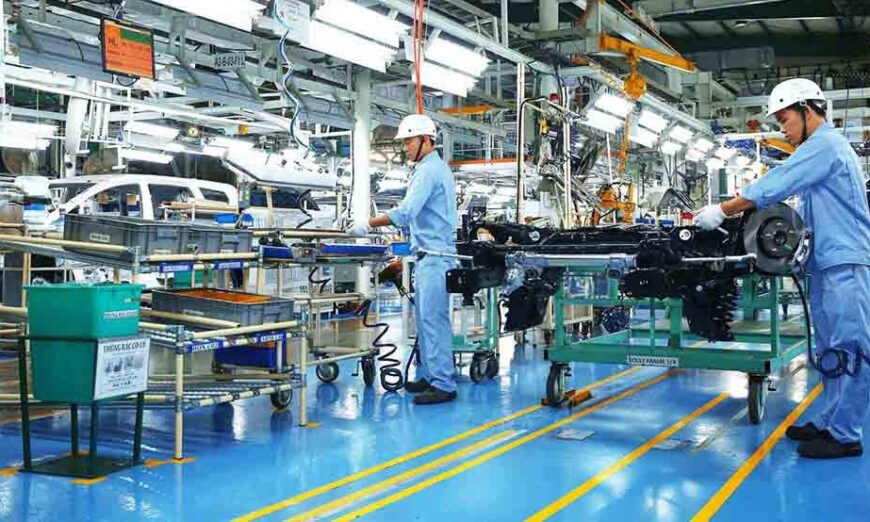Manufacturing
The Vietnamese manufacturing industry has boomed in recent years, and the country has continually grown its exports. In 2012, Viet Nam exported just over $114 trillion worth of goods — items ranging from textiles to electronics. By 2022, exports ballooned over $370 trillion, more than three times the size. As global businesses seek to diversify, increase resiliency and connectivity of their supply chains and decrease reliance on a single country, Viet Nam has become a top destination for investment in manufacturing due to its strategic location and advantages in shipping, competitive labour, and production costs. Compared to other Southeast Asian countries, Viet Nam stands out with international airports seaports, and rail links facilitating production flow and transportation.

A large middle class in India’s 1.3 billion population and its customs-duty exemption for ASEAN products make it a lucrative destination for Vietnamese exports. There is a notable scope for the development of services related to wholesale and retail trade, transportation and storage, and business support along with trade opportunities in cotton and knitted clothing. India’s salt to IT conglomerate, Tata Coffee, recently inaugurated their 5,000 MTPA freeze-dried coffee production plant in Binh Duong province of Viet Nam last year. This US$50 million coffee facility was commissioned within 19 months of the ground-breaking ceremony.
Electronics
Viet Nam’s electronics industry (EI) plays a crucial role in Viet Nam’s fast-growing economy contributing to Viet Nam’s successes in its manufacturing industry. Electronics industry in Viet Nam is mainly dominated by foreign companies, particularly multinational companies. The Vietnamese electronics industry has made significant strides in chip design and engineering. Several local companies have demonstrated their expertise in creating high-quality integrated circuits (ICs) and semiconductors for various applications. International giants like Synopsis, Intel, and Samsung Mobile have established research and development centres in Viet Nam, further bolstering the country’s chip design capabilities. In 2022, Samsung inaugurated its biggest research and development centre in Southeast Asia. The new research facility was opened in Hanoi at an estimated cost of $220 million.
An agreement to extend India- Viet Nam MoU on cooperation in the field of Information Technology was signed between India and Viet Nam. The MoU intends to foster active cooperation and exchange between private entities, Governments, institutions involved in enhancing capacity building and other public and private organizations of the two countries in the field of ICT.
Renewable Energy
Viet Nam has good renewable energy sources including solar, wind, biomass, and hydropower. Having renewable sources that are sufficient and readily available, the country is well-positioned to meet its surging energy needs through alternative power. The trend towards energy in Viet Nam has been reflected in the Master Plan for Power Development (PDP) over the past several years. There is a gradual shift towards renewable energy in Viet Nam alongside the conventional power generation industry. Viet Nam has followed the global trend of developing renewable energy. Taking advantage of its geographical location, Viet Nam is in the process of shifting its focus to renewable energy especially in the solar and on shore wind sectors. The Vietnamese government (GVN) has revised the Law on Electricity, Law on Economical and Efficient Use of Energy, and related laws to attract and encourage the public to use renewable energy. Because of Viet Nam’s industrial base continued rapid development, demand for energy is forecasted to increase by 8% by 2023.

During the visit of Prime Minister Narendra Modi both nations reaffirmed their shared commitment to sustainable development and climate action, while addressing their energy security as developing countries. Both sides will partner in new and renewable energy resources, energy conservation and other climate-resilient technologies. Viet Nam’s possible future participation in International Solar Alliance would bring new opportunities for cooperation in large scale deployment of solar energy.
Steel and metals
According to the analysis, in 2021, the production volume of crude steel in Viet Nam reached 26.15 million tons, representing a CAGR of 32.7% from 2013 to 2021. Seeing the huge potential of the steel market in Viet Nam and even Southeast Asia, many enterprises have invested in Viet Nam’s steel industry in recent years. The largest investment case is Formosa Ha Tinh Steel Corporation (FHS). Due to the rapid increase in production capacity of the steel industry in recent years, the supply of some types of steel in Viet Nam has exceeded the demand, including concrete iron or steel for construction, cold-rolled steel coil products, etc. In order to reduce large quantities of imports such as hot-rolled steel coils and electromagnetic steel sheets, the Viet Nam government is actively attracting foreign investors to establish positions in the country. It is estimated that, during 2020-2024, Viet Nam’s roads, airports and other infrastructure, housing construction, automobile, home appliances and other industries will all maintain a high growth rate.

Viet Nam’s finished steel production during the period stood at 13.1 million tonnes, down 20.9% over the same period in 2022. In 2022, production of finished steel products totalled 29.3 million tonnes, down 11.9% y-o-y, of which hot-rolled steel products reached about 18.2 million tonnes. Notably, exports to India rose sharply to 290,000 t compared with just 10,000 t in H1CY’22.
Tourism
Among the fastest-growing tourist destinations worldwide, Viet Nam is known for its long coastline, rice terraces, and old French-colonial architecture within bustling, modern cities. As Viet Nam shifted its heavy reliance on agriculture toward a service economy, tourism has been an essential part of economic growth in recent years. The country had one of the highest numbers of international tourist arrivals in the Asia Pacific region in 2019, with yearly increases in tourism receipts before 2020. Visitors from East Asian countries accounted for the largest group of international tourists in Viet Nam. The fact that larger countries regularly perform better in a comparison of the absolute number of guests is obvious. By putting the tourist numbers in relation to the population of Viet Nam, the result is much more comparable picture: With 0.039 tourists per resident, Viet Nam ranked 132nd in the world. In Southeast Asia, it ranked 3rd. In 2021, Viet Nam generated around 149.00 million US dollars in the tourism sector alone. This corresponds to 0.036 percent of it’s the gross domestic product and approximately 1 percent of all international tourism receipts in Southeast Asia.

In July 2023, “Promotion program on investment, trade and tourism between India and in Lao Cai – Viet Nam” was successfully held by the Lao Cai Provincial People’s Committee in collaboration with the Embassy of Viet Nam in India, Chamber of Commerce and Industry of Indian Importers and some chambers of commerce and associations of India, in New Delhi. By the end of 2023, there will be 60 direct flights per week between Viet Nam and India, from major cities of India and Viet Nam, creating great opportunities for sectors, especially tourism. Therefore, the trade promotion activities of localities to India, including Lao Cai, are very necessary and meaningful activities.
Food and Agriculture
In 2022, Viet Nam’s agricultural sector experienced its highest growth in recent years reaching 3.36 percent. Of this figure, farming increased by 2.88 percent, fisheries increased by 4.43 percent, and forestry increased by 6.13 percent. The export turnover of the whole industry was over US$53.22 billion. Viet Nam currently exports a broad range of agricultural products all over the world. Its main exports are walnuts, coffee, and rice – accounting for just over US$5.7 billion worth of agricultural exports in 2021.

The Viet Nam Trade Office in India, in collaboration with the National Investment Promotion and Facilitation Agency of India (Invest India), and the Federation of Indian Export Organisations (FIEO) held a teleconference on February 22 in which they discussed boosting trade in agriculture and processed food. India is Viet Nam’s 8th most significant trading partner, while Viet Nam is India’s 15th largest trading partner and the 4th biggest in Southeast Asia. This trade has developed in line with a number of trade agreements that have seen both countries benefit immensely. The India-Viet Nam Comprehensive Economic Cooperation Agreement also plays an important part in boosting trade between the two countries. It covers a range of areas, including trade in goods, trade in services, investment, and intellectual property rights.
Garment and Textile
The garment and textile industry are one of the key industries in Viet Nam with the second-largest export turnover in the country. In 2019, the industry’s export value contributed to 16 percent of total GDP. In the past five years, the textile industry has continuously grown at an average rate of 17 percent annually. One of the main competitive advantages of the Vietnamese manufacturing industry lies in its low labour cost, compared to its competitors such as China and Mexico. As a result, the industry has become one of the leading sectors for foreign direct investment in Viet Nam.
Consequently, the export of apparel products relies on the production of foreign-owned companies and local-private-owned subcontractors. Meanwhile, local production and imports address the growing domestic demand for apparel products.

Under the free trade agreement between India and the Association of South East Asian Nations (ASEAN), most cotton, woven cotton fabric and knitted fabric imported from India enjoy tax exemption from 2018, making India a competitive supplier of such materials and machines to Viet Nam. Indian businesses have invested in 201 big projects in Viet Nam.
Mining
The Comprehensive and Progressive Agreement for Trans-Pacific Partnership (CPTPP) outlines conditions for foreign investment in the mining sector in Viet Nam. Essentially, approval for foreign investment will only be granted if the investment project is deemed to bring net benefits to Viet Nam. In 2022, Viet Nam was the recipient of 108 foreign direct investment (FDI) projects in the mining industry, amounting to a combined registered capital of US$4.9 billion.

Viet Nam’s mining industry is diverse, with rare earth minerals becoming an increasingly important focus for the sector. This is driven by reports that the country has one of the largest reserves of rare earth minerals in the world. Furthermore, Viet Nam also has a favourable geographical location, with access to key markets in the region, such as China, Japan, and South Korea, which are major importers of rare earth minerals.
Recently Indian Ambassador P. Harish visited the Huu Nghi limestone mine of Huu Nghi Material Production Building Joint Stock Company in Thong Nhat Commune, Hoang Bo District of Quang Ninh Province and their jetty operations. India has been a key trade partner of Viet Nam in terms of metals and other mining outputs, with oil exploration undertaken by the Indian companies in the South China Sea in the past.

